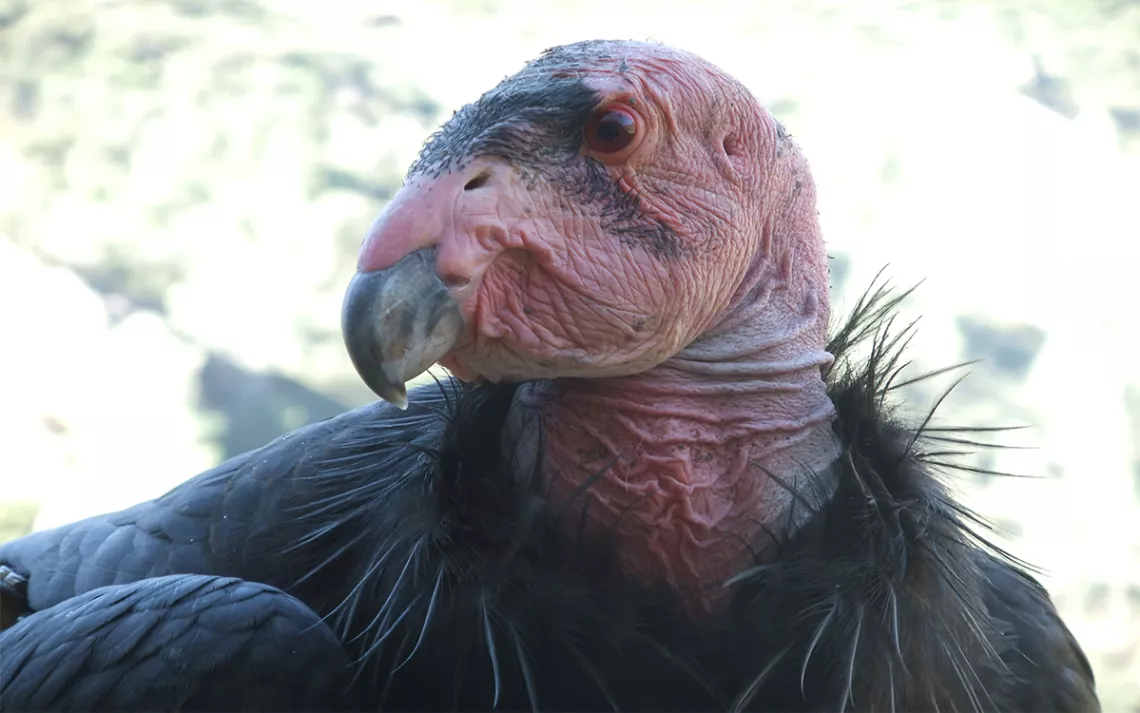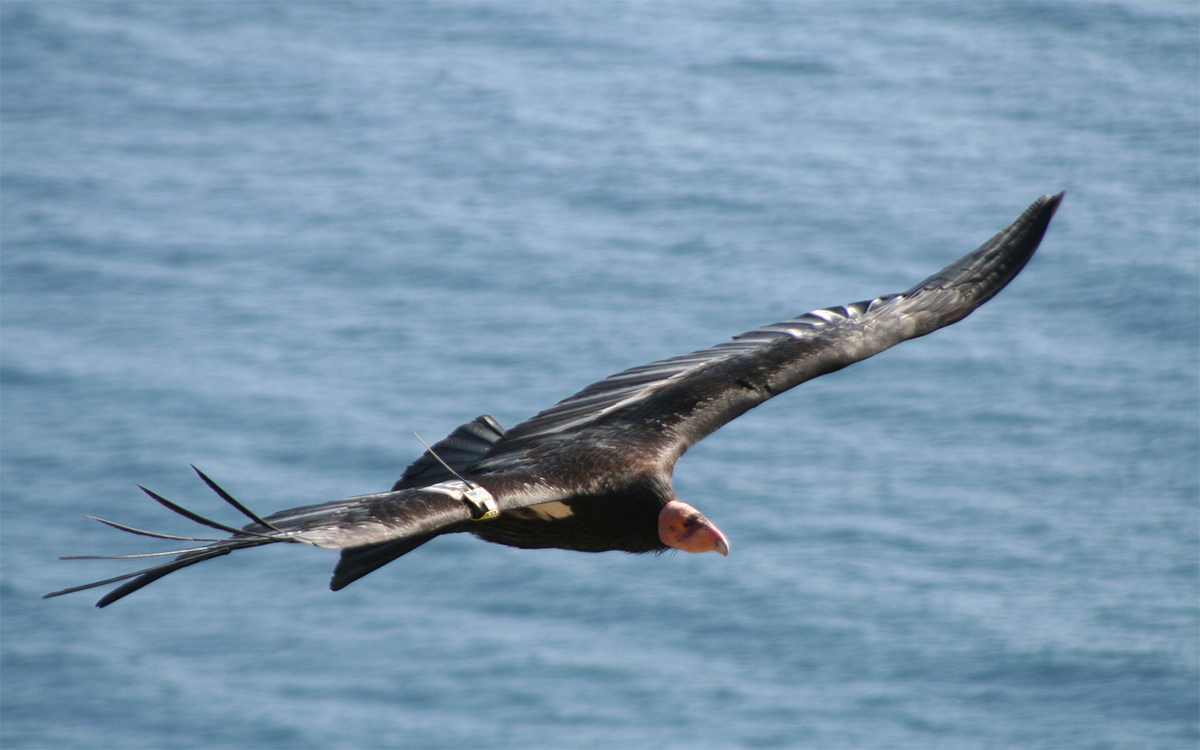How a Toxicologist Is Saving the California Condor With Science
Myra Finkelstein once put her body on the line. Now she wields data.

Photo by Daniel George
Sunlight streams through a narrow entryway in Myra Finkelstein’s lab, illuminating the clear plastic bottle that she holds up. Inside sits a rough, coal-colored bullet that looks disfigured—like it crumpled when it hit its target.
Colleagues of Finkelstein had fished the 0.22-caliber lead slug out of a California condor that died, not from a gunshot but because it was poisoned by eating the bullet. The dull metal might have lurked in a deer carcass or a gut pile that a hunter had left behind—appetizing meals to the scavenging bird. Like a forensic detective, Finkelstein had analyzed the chemical fingerprints of the lead in the bullet and the lead that poisoned the condor.
They matched.
Finkelstein, an environmental toxicologist at the University of California, Santa Cruz, has seen chronic and potentially deadly levels of lead from ammunition in hundreds of blood and feather samples from California condors. The birds once soared across the American West. But by 1982, the species had dwindled to only 22 individuals. Through intensive efforts to raise them in captivity and keep them alive in the wild, their numbers had crawled to 446 as of December 2016. But lead ammunition is suppressing the condor’s full-fledged recovery.
Finkelstein has been a pivotal figure in the fight to save California’s condors. In 2012, she and her colleagues showed that condors would never rebound if lead ammunition kept going down their gullets. Other studies had documented that lead ammo was poisoning the birds, but Finkelstein’s research team sealed the case.
Their work "made the biggest splash," says Chris Parish, who oversees a different flock of condors in Arizona for the Peregrine Fund, a nonprofit conservation group. “They nailed that stuff down with such great confidence. It's phenomenal.” And so was the payoff. Finkelstein's science, combined with her outreach and government testimony, ultimately led to the first statewide ban on lead ammunition in the country.
“I love figuring stuff out, and trying to generate information that solves problems,” says Finkelstein, a smile rising to her eyes. “I feel like I’m helping to save species.”
Photo by Zeka KuspaFinkelstein, a petite 51-year-old with sienna brown hair that she tucks behind her ears, looks at ease whether she’s wearing a white lab coat or typing up a research manuscript. Few would suspect that decades ago she was a brash activist, risking her safety to get in the way of fishermen and hunters who were killing animals she sought to protect. Eventually, she realized that she could fight more effectively as a scientist. Now, to make a difference, she wields data.
In the 80s, while an undergraduate at the University of California, Davis, Finkelstein joined Sea Shepherd, the confrontational marine conservation activist group, and sailed on missions in Alaskan waters that would last months. The group sought to prevent the use of drift nets—“curtains of death,” Finkelstein calls them—which extend for miles and catch everything in their path, including dolphins, sea turtles, and whales. Confrontations with drift-net fishers could be dangerous. “One ship threw knives at us,” she says.
In 1988, Finkelstein traveled to British Columbia, where the government was culling gray wolves. Government-paid hunters were luring the carnivores onto remote, frozen lakes with deer or caribou carcasses and shooting the wolves from helicopters. Finkelstein and two other leaders of the activist group Friends of the Wolf resolved to prevent the shooting by putting themselves in the potential line of fire.
The plan worked; the media coverage of their actions put a spotlight on the killings, and the government decided to postpone them until the activists left the wilderness. Yet something bigger was brewing. The nonprofit Western Canada Wilderness Committee had teamed up with Friends of the Wolf to sue the B.C. government to stop the aerial wolf kills for good. Finkelstein and her compatriots were dubious of working “through the system,” she recalls; they thought funds would be better spent on a plane to survey and disrupt more hunts. But under the leadership of Paul George, a scientist and founder of the committee, the environmental groups won their case.
That victory was when Finkelstein first began to consider the power of credentials and the limits of activism, she says. Physically interfering with a wolf kill might stop it for a few days in a single area, she says. “But it's not gonna stop it the next year, or the next year. And this [lawsuit] stopped that kill for almost 30 years.” (To her chagrin, the government reinstated the practice of shooting wolves from the skies in 2015. The official reason is to protect endangered caribou, though environmental groups argue that the government’s true motive is to keep more forest habitat available to loggers.)
In 1997, Finkelstein enrolled at UC Santa Cruz to pursue a graduate degree in ocean sciences just as the university’s environmental toxicology program was taking shape.
As a graduate student, Finkelstein investigated how heavy metals and persistent organic chemicals—for instance, mercury and DDE, a breakdown product of DDT—affect Laysan and black-footed albatrosses living on Midway Atoll in the Pacific Ocean. She describes them as amazing birds with personality. On the island, the juveniles get in a circle to dance, practicing for courtship, and they even let human visitors join them.
But Finkelstein found that baby Laysan albatrosses were nibbling the lead paint that was chipping off old military buildings on Midway, a former U.S. Naval territory. She knew a chick was poisoned when its wings drooped and dragged on the ground, Finkelstein says, letting her own arm go limp against her body to demonstrate. It’s a dead chick walking, “because they're not going to survive,” she says. “It was truly heartbreaking to be out there.”
After publishing her observations in 2003, Finkelstein wanted the government to clean up its peeling paint. She met with the Pentagon and the U.S. Fish and Wildlife Service. Everyone understood it was a problem, and it seemed so fixable, she recalls. But to her disbelief, the bureaucrats and politicians couldn’t fit the cleanup into their budgets.
Nonetheless, Finkelstein persisted. She teamed with Fish and Wildlife staff to advocate for the cause and published more studies detailing how lead was harming albatross numbers. Those efforts ultimately paid off: In 2010, the Department of the Interior designated Midway a Superfund site.
Finkelstein was thrilled. Fish and Wildlife finally had money to clean up Midway. “It was amazing. I couldn't believe it,” she says.

Photo by Joe Burnett
In 2008, Don Smith, a toxicologist at UC Santa Cruz who advised Finkelstein’s PhD work, recruited her for a different project: lead poisoning in California condors. Smith admired how independent, motivated, and collaborative Finkelstein was. And her track record showed she knew how to get things done.
Finkelstein often talks with a laid-back, California vibe; she thinks condors are “super cool.” A type of vulture, the birds have bald, pink heads and necks, and white patches on the undersides of their wings that interrupt their black plumage. With a 10-foot wingspan, they glide on updrafts and can fly for hundreds of miles.
Lead makes its way into the condor's diet in a few ways. The birds might gulp a whole bullet in a beakful of meat. Or, smaller pellets of metal, including birdshot and buckshot, can shred into a game animal like shrapnel that a scavenging condor then ingests. Lead rifle shot also shatters into hundreds of pieces on impact, scattering in its victim’s tissue.
Since 1999, conservationists have checked condor blood about twice a year for lead levels. And they trap the birds if they’re behaving strangely, a telltale sign of lead poisoning. If scientists find dangerous amounts of the metal, they whisk the bird to a zoo for chelation therapy, which soaks up the lead from the bird’s blood. The stressful treatment can take weeks or months, and such intensive interventions are costly.
Seven years ago, Finkelstein started fleshing out the lead problem by investigating condor feathers. As a feather grows, it records the lead that the bird is exposed to: a timeline of toxicity. A full feather contains about four months of exposure history, while blood only captures the past couple weeks. By snipping bits of feather from free-flying birds and analyzing them, Finkelstein could see how the lead levels were higher, and the exposures more frequent, than researchers had realized. Then in 2012, Finkelstein and colleagues examined more than a thousand condor blood samples and painted the most comprehensive picture of the bird’s plight to date.
They saw an epidemic. A staggering one in five free-flying condors was poisoned at any given time. And half the birds had sublethal levels that would still make them sick. The lead's isotopic composition or signature cemented the link to ammunition.
Some interest groups had clung to an alternative explanation that the main cause of lead poisoning in the birds was coming from trash or paint instead of ammunition, Finkelstein says. “We closed the door on that argument.”
But change doesn't happen on its own; scientists have to interpret their findings for voters and legislators, Finkelstein says. “You can’t just publish your paper. You have to go to them and say, ‘This is what it means, and this is how it’s relevant.’”
To get the lead out of condors, Finkelstein took her research results to the public. In 2013, she coauthored a letter signed by 30 scientists, doctors, and public health experts calling for the end of lead ammunition use. When a legislative bill proposed such a ban, she testified before the California Senate in its support.
The bill passed at the end of that year. “It was a ginormous win,” says Finkelstein. California plans to phase out lead ammunition by 2019. That benefits the health of the whole environment, including children who might be exposed to lead, she says. She hopes other states where condors and other scavengers are being poisoned, like Arizona, will follow California’s example.
Finkelstein continues to study condors, but she’s about to start analyzing lead in another iconic species. “We’re getting bald eagle feathers,” she says, rubbing her hands together in excitement.
What’s more, Finkelstein has her sights set on a big new target: the ubiquitous plastic trash that seabirds end up swallowing. On her desk, wrapped in a clear blue bag, is a black, potato-shaped “bolus”—undigested material that an albatross chick regurgitated. Besides squid beaks, the bolus has pieces of plastic in it, Finkelstein says. Just like every other bolus she has seen.
Plastic contains estrogen-like chemicals, which could be interfering with the birds' hormone signaling and, ultimately, their ability to survive and raise chicks. To study potential toxic effects in the lab, Finkelstein is trying to simulate the way a bird's stomach would leach the chemicals. Her team is currently concocting a recipe that mimics an albatross’s digestive juices.
Although Finkelstein had witnessed plastic pollution on Midway for over a decade, the problem is so widespread, she initially hadn’t thought her line of research could do much to solve it. But in 2013, collaborators approached her about looking at the effects of plastic on seabirds globally. At that scale, she says, “I feel like my work can actually make a difference.”
 The Magazine of The Sierra Club
The Magazine of The Sierra Club



